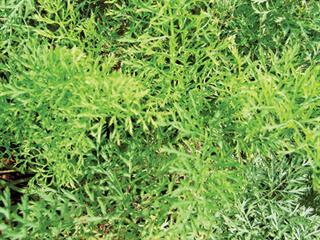
As mentioned last week, a carrot’s root system is enormous and grows deep into the soil, and this also needs to be taken into account. Old vegetable lands should not present a problem. If your yield was high, this will indicate that there are sufficient reserves in the soil, and a soil analysis will bear this out. Above all, there should be sufficient phosphorous, potassium and calcium in the soil at planting.
Potassium can leach into the subsoil. Because of this, you can often get good results even when the potash level is low. And there is usually enough phosphate where other vegetables have been grown. A deficiency is more likely in ‘new’ lands, and it shows up as stunted plants with a purple colouration on the lower leaves. The problem can be fixed by broadcasting phosphate fertiliser on the land; this will move sufficiently into the soil for the shallow feeder roots to take up.
A client who opened a new land planted potatoes using a fertiliser mixture at a high rate, as is customary for this crop, band-placed under the planted tubers in the usual way. As he was unaccustomed to fertilising carrots in a vegetable rotation, he followed the same procedure when planting carrots after the potatoes, knowing that he had applied 1t/ ha fertiliser mixture to the potatoes.
See also: Deeper roots, better carrots
What he did not take into account was that the fertiliser was band-placed. When the carrots started to grow, he noticed green strips in the land where the carrots were healthy, while the rest were stunted with purpling. The carrots were planted in beds made at a slightly different angle to the potato rows and it was perfectly clear where each potato row used to be by the straight green strips at an angle throughout the potato land.
The farmer immediately applied a good dose of phosphate. This quickly cleared up the problem and a few weeks later the land was perfectly uniform. Nitrogen is also often picked up by the carrots from deeper layers, where it has leached from previous applications.
Carrots penetrate the soil rapidly and at a young age the length of the root is disproportionate to the amount of leaf. The crop thus requires relatively little nitrogen at this stage, while the extensive root system is effective in foraging for all the required elements.
Maximising the sun’s energy
Sandy soils are a different matter, as nitrogen leaches easily from these. In this case, you might have to apply nitrogen in the early stages as a matter of course. The young plants must have sufficient nitrogen to develop leaves in an unrestricted manner. Close up the gaps between the rows to use as much sun energy as possible for the duration of the crop’s growth.
Nitrogen deficiency will always show as lighter patches with shorter leaves. Once the leaves are sufficient to make full use of sunlight, nitrogen is much less important; good yields can still be expected even when the leaves are a relatively light colour. I conducted trials where, with a high nitrogen application, the leaves were a very dark green colour and almost waist high, but yielded the same as the plot alongside with an adequate growth of leaves and a light colour.
If you require a stronger top for mechanical harvesting or bunching, you will need to apply more nitrogen, but it will not increase the root yield.
Molybdenum deficiency
The soil pH should not be too low and calcium is important for all crops. If the pH is slightly low, but still adequate, you can expect a molybdenum deficiency. This always results in patches in the land that are stunted and a lighter colour. On closer inspection, you will find that the leaves have a pale chlorosis and may even burn at the edges. A single dose of sodium molybdate at about 50g/ha as a foliar spray will correct this.












